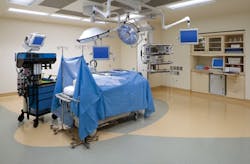Health Tech
By Tod Moore, RCDD, CSI, and Nathan Larmore, CCNP, ICNC, MCSE
When designers sat down to plan Platte Valley Medical Center (PVMC) in Brighton, CO, they weren't just thinking about what the facility would need the day it opened, or even 10 or 20 years down the line: They had a 50-year plan in mind.
"Our challenge was to create a 100-bed hospital with the ability to grow to a 300-bed hospital. Flexibility and adaptability are the keys to the facility's ability to meet that desire," says Anthony Haas, senior principal and senior medical planner for WHR Architects, which partnered with Fentress Bradburn Architects to design the $138 million, 280,000-square-foot replacement hospital. Leading-edge technology and communications systems are integral to the facility's success and future growth potential.
Shrinking Staff, Growing Needs
PVMC and other healthcare organizations around the nation are facing monumental challenges in the changing healthcare marketplace. Staff shortages, changing payment strategies, and savvy healthcare "consumers" are demanding innovative tools. An April 2006 report by the Association of American Medical Colleges predicts a shortage of up to 200,000 physicians by the year 2020. Studies conducted by healthcare think tanks have said that healthcare owners will rely heavily on technology to bridge gaps between availability, access, and the drive toward improving operational efficiencies and costs.
Venturing into New Technology
Understanding the impact new technology would make on PVMC's infrastructure, the design team undertook a technology visioning process early in design. They evaluated various methods of leveraging facility-wide systems to support all departments with several broad goals being realized:
- A cabling system to support the facility's information technology and building control requirements
- A campus local area network (LAN) to support numerous applications, including medical records, medical equipment, voice and video communications, building security, resource tracking, and various other systems that are moving to the IP-based network
- A robust, but flexible, data center to support long-term planning
- A single wireless system to safely support all mobile needs, including two-way facility radios, emergency responder communications, public Internet access, cellular phones and personal digital assistants (PDAs), medical records, and order entry
The Power and Impact of Convergence
The PVMC team used convergence as their most powerful tool. Converging technologies onto a single platform in both the wired and wireless environments meant distributing different low-voltage systems over the same structured cabling and logical data network systems. To avoid an overabundance of wireless systems, the team deployed Internal Re-radiating Systems (IRS) - by providing a standardized radio frequency antenna system, many of the wireless systems, once requiring individual, proprietary systems, are transmitted over one antenna. This greatly reduces the "antenna jungle" that is often seen in large healthcare facilities and provides economies in maintenance and administration as well as flexibility for growth.
Wired technology systems are streamlined at PVMC by running various low-voltage systems over one standardized structured cable infrastructure and one common data network. The result is secure, environmentally controlled spaces distributed on a single cable system.
Economies also realized by convergent technology are PVMC's use of Voiceover IP (VoIP) telephony. By running voice and data networks over the same structured cable plant, the hospital reduced the amount of copper cable needed, decreasing construction costs and providing greater flexibility as it relates to moves, adds, or changes to operational needs.
To future-proof the facility, the building team made sure the wireless system included emergency and maintenance radios; clinical and enterprise data connections; patient telemetry and physiological monitoring; wireless phone systems; personal digital assistants; cellular phones; future RFID (radio frequency identification) asset tracking; and infant abduction systems.
Bringing Care "Closer to the Bedside"
According to Harold Dupper, PVMC chief financial officer, among the many attributes, the new technology systems will allow for a "direct connection between the patient and specific staff. COWs (Computers on Wheels) allow us to get patients entered into the care system more quickly, while admission paperwork is completed from the bedside in the ER. The facility-wide wireless system provides efficiencies in data entry, such as computerized physician order entry systems and information retrieval, such as electronic medical records systems." By providing wireless access to these and other systems, the caregiver can spend less time performing administrative tasks at the workstation and more time with the patient.
With the help of forward-thinking owners, architects, and designers, PVMC has become a pioneer in the healthcare technology arena, implementing systems that will allow it to serve today's community and to be flexible and adaptable for the road ahead.
Tod Moore ([email protected]) is principal of technology consulting and Nathan Larmore ([email protected]) is an associate and information technology consultant at Sparling, a leading healthcare technology consulting firm headquartered in Seattle, WA, with offices in Portland, OR, and San Diego. For more information go to www.sparling.com.
